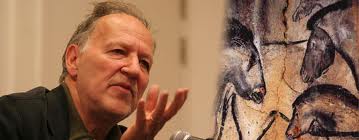
The Score’s The Thing in Herzog’s Cave
During Warner Herzog’s odyssey into glittering Chauvet Cave, whose walls are graced with startlingly fresh images of woolly rhinos, lions, horses, mammoths, painted by torchlight some 32,000 years ago, the camera rises operatically out of skeletal rows of a vineyard to reveal Pont d’Arc, a massive limestone archway spanning the Adreche River. Its resemblance to the mouth of a cave is obvious, an immense geological trope echoing the original entrance to Chauvet before a rockslide 20,000 years ago sealed it off until rediscovery in 1994. It is a numinous passage, as mythically resonant as the landscapes of Wagner or the German Romantics.
When the reflections on the river are right, the archway way rounds itself into an aperture, an eye. To the philosophical Herzog “it is as if,” in this place, “the modern human soul awakened all at once” — into painting, ceremony, the coming figurations of sculpture, music. And eventually, of course, full circle to the moving firelight of Cave of Forgotten Dreams.
Herzog shoots the first descent into the cave through wobbly hand-held cameras. Walls, beards of stalactites and phallic stalagmites are suddenly there in passing radiance. Human shadows slip across the rocks, then fade. Under his hard hat and miner’s light, Herzog, arch documentarian and monk, looks into the camera while explaining the considerable constraints in filming Chauvet.
Arriving at the cave’s bottom with crew and scientists, he calls for silence, but moments later, stages a pretentious but forgivable recording of a human heart.

Though breathtaking, the paintings seemed diminished by the protean cave that is Herzog’s film. I was uneasy with the competitive tension that the movie smells of: director and his work out-angling shamanic painters and their ancient images.
Yet Herzog would have us believe cinema is itself an extension of Chauvet– cave paintings torchlit by the projector’s particled light. Even the shadows that must have been cast by the artists moving in front of the fires come alive again with an audacious cameo by Fred Astaire from the 1936 musical, Swing Time – a legendary sequence featuring three giant shadows of the dancer mimicking in perfect sync (almost) his every elegant move.
But Ernst Reijseger’s score holds uncontested dominion. Its relentless presence seemed on first hearing to seal off the film from a quieter, contemplative light: the cellos can gnaw at the nerves, claw as bears once did across the painting’s pristine surface. I wanted to forgive the evocations of Gregorian chant and medieval motets for their insistent sacred rhetoric and the modernist overreaching for strangeness. Yet, I heard in that same strangeness and extraordinary scale a kind of mytho-poetic anthropology — gorgeous, archaic, and experimental.  Intended or not, the instruments haunt with snarls, cries, roarings. These are not “sound effects,” but inherited traits in the music. As movies can claim descent from wall pageants illuminated by firelight, Reidjegar pays homage to the windpipes,the anatomy of vulture bone, the uses of gut and hollowed wood. Bach’s Suites for Unaccompanied Cello shape- shift all over the place, formal craft growing feral and the phrasing like flies humming.
Intended or not, the instruments haunt with snarls, cries, roarings. These are not “sound effects,” but inherited traits in the music. As movies can claim descent from wall pageants illuminated by firelight, Reidjegar pays homage to the windpipes,the anatomy of vulture bone, the uses of gut and hollowed wood. Bach’s Suites for Unaccompanied Cello shape- shift all over the place, formal craft growing feral and the phrasing like flies humming.
At film’s end, the two baby albino crocodiles performing synchronized swimming in a tropical biosphere near the cave is something of a crock, as is Herzog’s cloying voiceover. I thought instead to turn the cave inside out, release the animals to their original epic. The music would best be performed on a glacier under moon, the dome of the night the only cave large enough.

Unfortunately, the music was used way too much!! My reaction was “enough already” with the music – please just let us hear the ambient sounds and observe the cave paintings. It was the music that competed too much with the visuals, in my opinion.